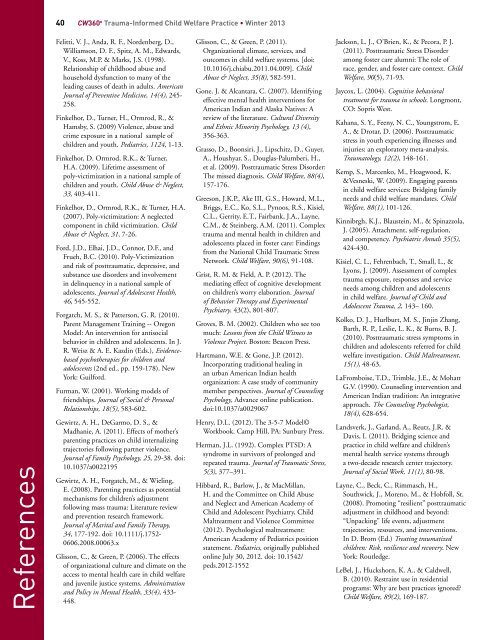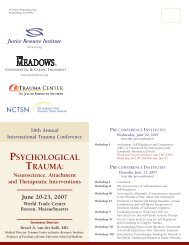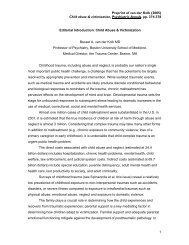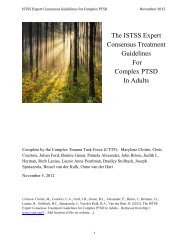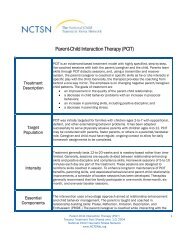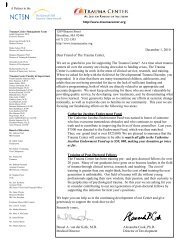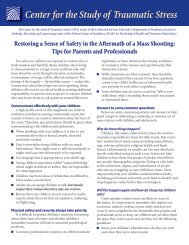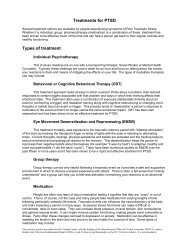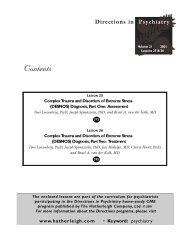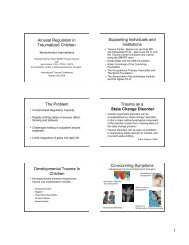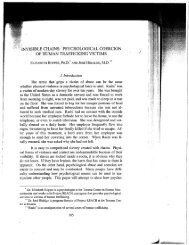in Child Welfare - The Trauma Center
in Child Welfare - The Trauma Center
in Child Welfare - The Trauma Center
You also want an ePaper? Increase the reach of your titles
YUMPU automatically turns print PDFs into web optimized ePapers that Google loves.
40 CW360 o <strong>Trauma</strong>-Informed <strong>Child</strong> <strong>Welfare</strong> Practice • W<strong>in</strong>ter 2013ReferencesFelitti, V. J., Anda, R. F., Nordenberg, D.,Williamson, D. F., Spitz, A. M., Edwards,V., Koss, M.P. & Marks, J.S. (1998).Relationship of childhood abuse andhousehold dysfunction to many of thelead<strong>in</strong>g causes of death <strong>in</strong> adults. AmericanJournal of Preventive Medic<strong>in</strong>e, 14(4), 245-258.F<strong>in</strong>kelhor, D., Turner, H., Ormrod, R., &Hamsby, S. (2009) Violence, abuse andcrime exposure <strong>in</strong> a national sample ofchildren and youth. Pediatrics, 1124, 1-13.F<strong>in</strong>kelhor, D. Ormrod, R.K., & Turner,H.A. (2009). Lifetime assessment ofpoly-victimization <strong>in</strong> a national sample ofchildren and youth. <strong>Child</strong> Abuse & Neglect,33, 403-411.F<strong>in</strong>kelhor, D., Ormrod, R.K., & Turner, H.A.(2007). Poly-victimization: A neglectedcomponent <strong>in</strong> child victimization. <strong>Child</strong>Abuse & Neglect, 31, 7-26.Ford, J.D., Elhai, J.D., Connor, D.F., andFrueh, B.C. (2010). Poly-Victimizationand risk of posttraumatic, depressive, andsubstance use disorders and <strong>in</strong>volvement<strong>in</strong> del<strong>in</strong>quency <strong>in</strong> a national sample ofadolescents. Journal of Adolescent Health,46, 545-552.Forgatch, M. S., & Patterson, G. R. (2010).Parent Management Tra<strong>in</strong><strong>in</strong>g -- OregonModel: An <strong>in</strong>tervention for antisocialbehavior <strong>in</strong> children and adolescents. In J.R. Weisz & A. E. Kazd<strong>in</strong> (Eds.), Evidencebasedpsychotherapies for children andadolescents (2nd ed., pp. 159-178). NewYork: Guilford.Furman, W. (2001). Work<strong>in</strong>g models offriendships. Journal of Social & PersonalRelationships, 18(5), 583-602.Gewirtz, A. H., DeGarmo, D. S., &Madhanie, A. (2011). Effects of mother’sparent<strong>in</strong>g practices on child <strong>in</strong>ternaliz<strong>in</strong>gtrajectories follow<strong>in</strong>g partner violence.Journal of Family Psychology, 25, 29-38. doi:10.1037/a0022195Gewirtz, A. H., Forgatch, M., & Wiel<strong>in</strong>g,E. (2008). Parent<strong>in</strong>g practices as potentialmechanisms for children’s adjustmentfollow<strong>in</strong>g mass trauma: Literature reviewand prevention research framework.Journal of Marital and Family <strong>The</strong>rapy,34, 177-192. doi: 10.1111/j.1752-0606.2008.00063.xGlisson, C., & Green, P. (2006). <strong>The</strong> effectsof organizational culture and climate on theaccess to mental health care <strong>in</strong> child welfareand juvenile justice systems. Adm<strong>in</strong>istrationand Policy <strong>in</strong> Mental Health, 33(4), 433-448.Glisson, C., & Green, P. (2011).Organizational climate, services, andoutcomes <strong>in</strong> child welfare systems. [doi:10.1016/j.chiabu.2011.04.009]. <strong>Child</strong>Abuse & Neglect, 35(8), 582-591.Gone. J. & Alcantara, C. (2007). Identify<strong>in</strong>geffective mental health <strong>in</strong>terventions forAmerican Indian and Alaska Natives: Areview of the literature. Cultural Diversityand Ethnic M<strong>in</strong>ority Psychology, 13 (4),356-363.Grasso, D., Boonsiri, J., Lipschitz, D., Guyer,A., Houshyar, S., Douglas-Palumberi, H.,et al. (2009). Posttraumatic Stress Disorder:<strong>The</strong> missed diagnosis. <strong>Child</strong> <strong>Welfare</strong>, 88(4),157-176.Greeson, J.K.P., Ake III, G.S., Howard, M.L.,Briggs, E.C., Ko, S.L., Pynoos, R.S., Kisiel,C.L., Gerrity, E.T., Fairbank, J.A., Layne,C.M., & Ste<strong>in</strong>berg, A.M. (2011). Complextrauma and mental health <strong>in</strong> children andadolescents placed <strong>in</strong> foster care: F<strong>in</strong>d<strong>in</strong>gsfrom the National <strong>Child</strong> <strong>Trauma</strong>tic StressNetwork. <strong>Child</strong> <strong>Welfare</strong>, 90(6), 91-108.Grist, R. M. & Field, A. P. (2012). <strong>The</strong>mediat<strong>in</strong>g effect of cognitive developmenton children’s worry elaboration. Journalof Behavior <strong>The</strong>rapy and ExperimentalPsychiatry. 43(2), 801-807.Groves, B. M. (2002). <strong>Child</strong>ren who see toomuch: Lessons from the <strong>Child</strong> Witness toViolence Project. Boston: Beacon Press.Hartmann, W.E. & Gone, J.P. (2012).Incorporat<strong>in</strong>g traditional heal<strong>in</strong>g <strong>in</strong>an urban American Indian healthorganization: A case study of communitymember perspectives. Journal of Counsel<strong>in</strong>gPsychology, Advance onl<strong>in</strong>e publication.doi:10.1037/a0029067Henry, D.L. (2012). <strong>The</strong> 3-5-7 Model©Workbook. Camp Hill, PA: Sunbury Press.Herman, J.L. (1992). Complex PTSD: Asyndrome <strong>in</strong> survivors of prolonged andrepeated trauma. Journal of <strong>Trauma</strong>tic Stress,5(3), 377–391.Hibbard, R., Barlow, J., & MacMillan,H. and the Committee on <strong>Child</strong> Abuseand Neglect and American Academy of<strong>Child</strong> and Adolescent Psychiatry, <strong>Child</strong>Maltreatment and Violence Committee(2012). Psychological maltreatment:American Academy of Pediatrics positionstatement. Pediatrics, orig<strong>in</strong>ally publishedonl<strong>in</strong>e July 30, 2012. doi: 10.1542/peds.2012-1552Jackson, L. J., O’Brien, K., & Pecora, P. J.(2011). Posttraumatic Stress Disorderamong foster care alumni: <strong>The</strong> role ofrace, gender, and foster care context. <strong>Child</strong><strong>Welfare</strong>, 90(5), 71-93.Jaycox, L. (2004). Cognitive behavioraltreatment for trauma <strong>in</strong> schools. Longmont,CO: Sopris West.Kahana, S. Y., Feeny, N. C., Youngstrom, E.A., & Drotar, D. (2006). Posttraumaticstress <strong>in</strong> youth experienc<strong>in</strong>g illnesses and<strong>in</strong>juries: an exploratory meta-analysis.<strong>Trauma</strong>tology, 12(2), 148-161.Kemp, S., Marcenko, M., Hoagwood, K.&Vesneski, W. (2009). Engag<strong>in</strong>g parents<strong>in</strong> child welfare services: Bridg<strong>in</strong>g familyneeds and child welfare mandates. <strong>Child</strong><strong>Welfare</strong>, 88(1), 101-126.K<strong>in</strong>nibrgh, K.J., Blauste<strong>in</strong>, M., & Sp<strong>in</strong>azzola,J. (2005). Attachment, self-regulation,and competency. Psychiatric Annals 35(5),424-430.Kisiel, C. L., Fehrenbach, T., Small, L., &Lyons, J. (2009). Assessment of complextrauma exposure, responses and serviceneeds among children and adolescents<strong>in</strong> child welfare. Journal of <strong>Child</strong> andAdolescent <strong>Trauma</strong>, 2, 143– 160.Kolko, D. J., Hurlburt, M. S., J<strong>in</strong>j<strong>in</strong> Zhang,Barth, R. P., Leslie, L. K., & Burns, B. J.(2010). Posttraumatic stress symptoms <strong>in</strong>children and adolescents referred for childwelfare <strong>in</strong>vestigation. <strong>Child</strong> Maltreatment,15(1), 48-63.LaFromboise, T.D., Trimble, J.E., & MohattG.V. (1990). Counsel<strong>in</strong>g <strong>in</strong>tervention andAmerican Indian tradition: An <strong>in</strong>tegrativeapproach. <strong>The</strong> Counsel<strong>in</strong>g Psychologist,18(4), 628-654.Landsverk, J., Garland, A., Reutz, J.R. &Davis, I. (2011). Bridg<strong>in</strong>g science andpractice <strong>in</strong> child welfare and children’smental health service systems througha two-decade research center trajectory.Journal of Social Work, 11(1), 80-98.Layne, C., Beck, C., Rimmasch, H.,Southwick, J., Moreno, M., & Hobfoll, St.(2008). Promot<strong>in</strong>g “resilient” posttraumaticadjustment <strong>in</strong> childhood and beyond:“Unpack<strong>in</strong>g” life events, adjustmenttrajectories, resources, and <strong>in</strong>terventions.In D. Brom (Ed.) Treat<strong>in</strong>g traumatizedchildren: Risk, resilience and recovery. NewYork: Routledge.LeBel, J., Huckshorn, K. A., & Caldwell,B. (2010). Restra<strong>in</strong>t use <strong>in</strong> residentialprograms: Why are best practices ignored?<strong>Child</strong> <strong>Welfare</strong>, 89(2), 169-187.


